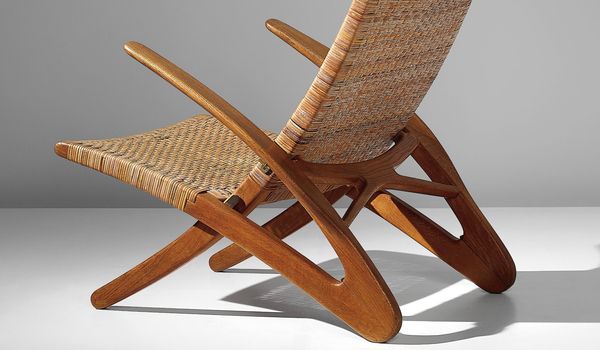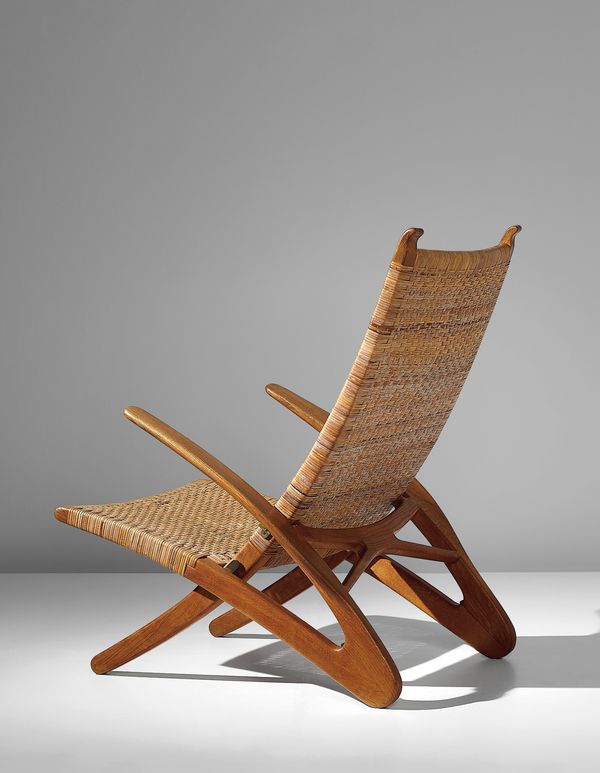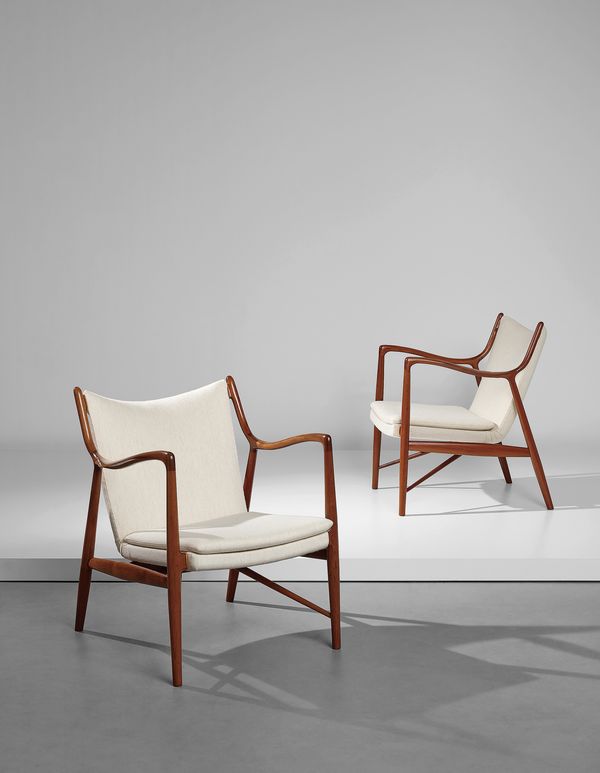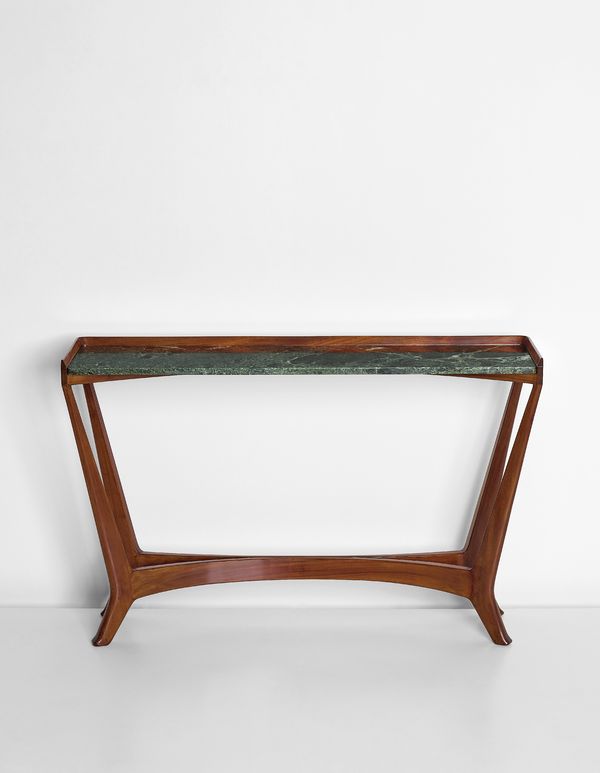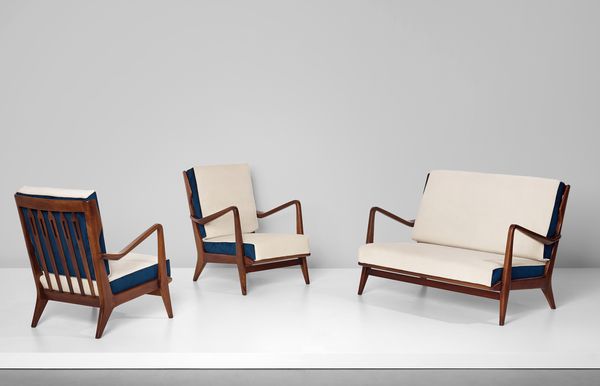Detail of Hans J. Wegner Rare 'Dolphin' folding armchair, model no. JH510
The architect Hans J. Wegner infused a deep sense of playfulness into his 'Dolphin' lounge chair, the first of our highlights from Hong Kong's 20th Century & Contemporary Art & Design Evening Sale. This rare model conveys the movement and energy—specifically the lyricism and speed—of a dolphin in the ocean, culminating in the sculptural, carved cantilevered armrests that boldly project forward motion.
Hans J. Wegner Rare 'Dolphin' folding armchair, model no. JH510. Designed 1950, produced late 1950s
In its modernist beauty and superb craftsmanship, the 'Dolphin' is a poetic example of the fruitful collaboration between Wegner and the esteemed Copenhagen master cabinetmaker Johannes Hansen. The 'Dolphin' stands out as a clear and profound expression of the designer's deeply-felt humanist interest in furniture's adaptability to human forms and needs—in this case, the modern capacity to transform for transport—which are subjects he would explore throughout his career as he refined the expression of his ideas and values through furniture. In Wegner's own words, "I have the feeling that the more I work on it, the more it keeps moving farther and farther away. Maybe it does, maybe it doesn't. You can't make something definitive."
The above model was exhibited at the Copenhagen Cabinetmakers' Guild, Kunstindustrimuseet, Copenhagen, 22 September-8 October 1950, Stand 19. We wish to thank Marianne Wegner from the Hans J. Wegner Design Studio for her assistance with the cataloguing of this important piece.
Finn Juhl Pair of armchairs, model no. FJ 45. Designed 1945, produced 1950s
Next, we look at a pair of armchairs, model no. "FJ 45" produced in Bangkok Teak. These were designed by the Danish architect Finn Juhl and executed by the master cabinetmaker Niels Vodder for the Cabinetmakers' Guild, held at the Kunstindustrimuseet, Copenhagen where the design was first exhibited in 1945.
From 1944 and continuing into the 1950s, Finn Juhl designed some of his finest cabinet-made furniture for the Cabinetmakers' Guild, and the "FJ 45" armchair must be considered one of his most accomplished and revered designs. During this period, Juhl created the "FJ 44" dining chair that was then described by one critic as having "a sculptural form which apparently strains the wood to its upmost limits." Then followed the "FJ 45" armchair that was celebrated for its frame, "which is beautifully modelled or organic like a bone," as stated by the Danish architect Erik Herløw in the periodical Arkitekten. The "FJ 45" demonstrates tthe exquisite use of Bangkok Teak, importantly Juhl's primary choice of timber, handcrafted, accentuated organic stiles and arms with elegantly carved wings.
Each year during this period Juhl presented designs at the Cabinetmakers' Guild that were executed by Vodder. The synergy and symbiosis of these two artistic characters created iconic masterpieces of 20th-century design. Always an original contributor to the Cabinetmaker's Guild, Juhl would receive many favorable responses from the critics: "Finn Juhl's designs continue the course of development which has characterized his contributions to the past four or five exhibitions. Finn Juhl has undoubtedly been our most prominent furniture designer these past few years, and he is the one who has made the sincerest effort to comply with the requirements which a designer participating in the cabinetmakers' exhibition is naturally expected to fill."
When discussing the cabinetmaker Niels Vodder, the Danish architectural journalist Henrik Sten Møller refers to him as an "original craftsman with a distinct sense of humor." He then goes further to explain why Vodder would have ever had agreed to collaborate with Juhl: "The reason why Niels Vodder became Finn Juhl's cabinetmaker was that nobody else wanted to produce his furniture. They thought the furniture too strange and furthermore often technically complicated."
Osvaldo Borsani Rare console, designed for the IX Triennale, Milan, circa 1951
The above model was exhibited as part of a dining room designed by the architect Osvaldo Borsani at the 1951 IX Milan Triennale. The exhibition presented houses of the future, inspired by a new period of optimism in Italy developing within the framework of economic, social and cultural restoration following the war. Embracing new ideological and technological advances, Borsani played an instrumental role in the formation of Italian modernist design while remaining dedicated to the country's tradition of craftsmanship and quality of materials.
Executed using walnut and marble, Borsani's console for the IX Triennale features traditional materials, which he exploits for their expressive and sculptural potential. The refined, curved shape of the wood base simultaneously supports and frames the marble tabletop, softening the solid, linear form. The resulting simplicity of form reflects a renewed interest by Italian designers in Scandinavian design during the 1950s, which was instructive in terms of its combined democratic ideology and craftsmanship. This lot thus demonstrates Borsani's ability to interpret the formal elegance of Italian design through a modernist sensibility.
This piece was exhibited at the 'IX Triennale di Milano Esposizione internazionale delle arti decorative e industriali moderne e dell'architettura moderna', Triennale di Milano, Milan, 1951.
Gio Ponti Pair of armchairs, circa 1958, and settee, circa 1950, model no. 516
Gio Ponti, who features amongst the most prolific talents to grace 20th-century design, collaborated with Figli di Amedeo Cassina in the 1950s and produced the above model no. 516, armchairs and settee, which are included in the Hong Kong Century & Contemporary Art & Design Evening Sale.
